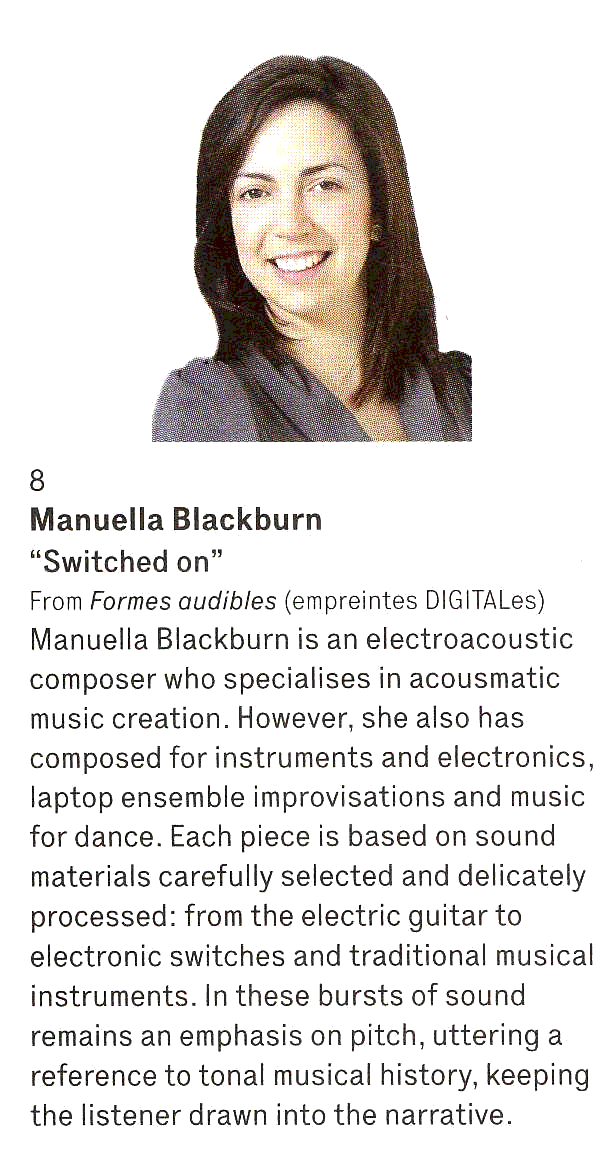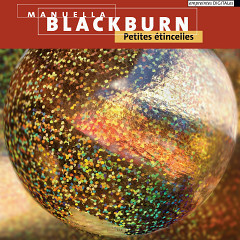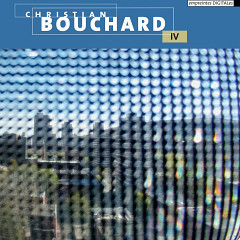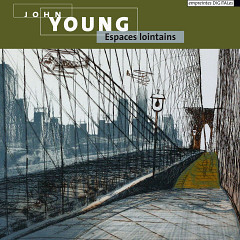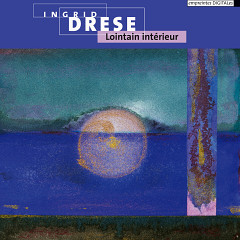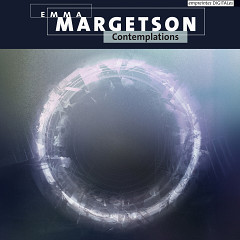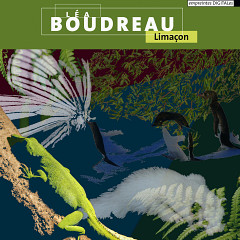… an ontologically expansive, electroacoustic orgy. […] on the redoubtable empreintes DIGITALes label… I cannot overstate just how exciting and refreshing this music is. — The Sound Projector, UK
Ces musiques sont sans aucun doute porteuses d’une voix originale à découvrir, et à suivre… — Circuit, Québec
Manuella Blackburn’s work brilliantly embodies the vivid side of modern acousmatic music. This first disc of the Manchester-based British composer will keep the listener’s mind awake from the first to the last second. One will find dynamic works where the discourse is articulated with incredible finesse. Each element is precisely organized within complex timbre structures of great clarity. Each piece is based on sound materials carefully selected and delicately processed: from the electric guitar, to electronic switches to traditional musical instruments. In these bursts of sound remains an emphasis on pitch, uttering a reference to tonal musical history, keeping the listener drawn into the singular narrative of a frankly lively work.
- Composer(s): Manuella Blackburn
- Cover image: Mark Mushet
- Mastering: Dominique Bassal
- Liverpool Hope University
CD (IMED 12117, 2012)
- 1Vista Points (2009), 10:08fixed medium
- 2Switched on (2011), 7:58fixed medium
- 3Karita oto (2009), 14:42fixed medium
- 4Kitchen Alchemy (2007), 11:31fixed medium
- 5Cajón! (2008), 8:59fixed medium
- 6Spectral Spaces (2008), 10:35fixed medium
- Label: empreintes DIGITALes
- IMED 12117
- 2012
- UCC 771028211753
- Total duration: 64:08
- OGpak
- 125 mm × 125 mm × 10 mm
- 50 g
On the web
Download (IMED 12117_NUM, 2012)
- This item can be downloaded and/or listened to at empreintesdigitales.bandcamp.com.
- 1Vista Points (2009), 10:08fixed medium
- 2Switched on (2011), 7:58fixed medium
- 3Karita oto (2009), 14:42fixed medium
- 4Kitchen Alchemy (2007), 11:31fixed medium
- 5Cajón! (2008), 8:59fixed medium
- 6Spectral Spaces (2008), 10:35fixed medium
- Label: empreintes DIGITALes
- IMED 12117_NUM
- 2012
- UCC 771028211784
- Total duration: 64:08
Some recommended items
In the press
A Six-Part Syntax of Sound
If ever there were just cause not to judge a book (or CD) by its cover then this is it. The sleeve’s hazy smudge of tame blue and yellow is more indicative of a Rothko-esque William Basinski rip-off than an ontologically expansive, electroacoustic orgy. Look more closely though and a telling detail reveals that this is another CD on the redoubtable empreintes DIGITALes label, whose bold claim to be ‘the world leader in electroacoustic/acousmatics’ will solidly stand-up to any bench test. In fact, given the daring new vocabularies voiced on recordings such as this, the debut from the UK’s Manuella Blackburn, I’m visited by an overpowering sense that I am the one being tested.
One need only glance at Blackburn’s biography to be dazzled: barely in her thirties, she is a lecturer in Music Technology at Manchester University [Liverpool Hope University] and has already taken home a slew of illustrious awards from international electronic music events. However, venture into the music and you will find yourself lost for words. Ina-GRM fiends may find themselves at home amidst this spellbinding selection of surgically sculpted, swiftly shifting sounds and tunneling tones, cosmic flourishes and vacuumed hushes; all emulsified by a convulsive cohesiveness that obviates any hint of homogeneity, while marking every tone as Blackburn’s own. However, for other listeners it may be like ‘spherical trigonometry for the inhabitants of Flatland’, as Aleister Crowley put it.
Track titles range from the open-ended (Switched on, Vista Points, Kitchen Alchemy and Spectral Spaces) to those of a more orientalist ambiguity (Karita oto and Cajón!). More than merely cursory designations, they successfully signpost the strange realms of sonic mysteries (to be) traversed not just by the listener, but the composer as well. Blackburn has personally articulated the discovery process by which she arrived at certain source sounds, before proceeding with an exploratory process of creating cohesive (if temperamental) compositions. The latter titles – more exotic designations – depict encounters between origins foreign and familiar perhaps found during the composer’s travels, as does the use of a French title for the collection.
These six compositions were realised between 2007 and 2011. All throughout, sound sources from guitar to household appliances are rubbled to clouds of recognisable remnants that are animated into play perhaps best viewed in infrared, as they are climatologically morphed in a febrile, fluctuating maelstrom. Some of the recurring ‘audible forms’ include pointillistic flutters in particle accelerators, powdered performance samples draped over air currents, punctuated by split-second stabs of alien alloys, plunged into low-density liquids, and tucked into electro-gossamer sheets of pure tone. Fans of Bernard Parmegiani or Francis Dhomont may find themselves on familiar ground, but will equally be delighted at so fresh and authentic a manner of articulation.
In Vista Points, flurries of improvised guitar are fleshed out, strings amplified to an almost glassy pitch, and spray-painted with myriad layers of twittering designer genes. The resulting ‘causality, conflict and turbulence’ is captivating, especially so in the sudden moments, when the piece’s initial stability yields to a terrible tension between explosive pressure and release/tentative stillness and paralysing presence, and the atmosphere is engorged with crackling clouds of electrons.
The sound source in Switched on is an aged television, from the wake-up stage of which the composer has coaxed unfamiliar flutters and frequencies – some just a split second in duration – and painstakingly corralled them into a towering cake of ‘cascades and explosive flourishes’. The realised piece – a polyphony between chimes and switches in alternating on/off states of animation – surges with the electrical life force of a seemingly dormant device, which depiction succinctly epitomises much of Blackburn’s composition: originating in a static state, suddenly seething violently but with volition and direction seemingly more evolved than the sensory apparatus of the listener.
Karita oto (‘borrowed sound’) derives equally from a number of traditional Japanese instruments (the samples were taken during a 2008 trip to Tokyo), and ‘compositional strategies developed from Denis Smalley’s spectromorphology’. The piece follows an ‘episodic structure’ through which ‘cultural’ sounds are deconstructed to their very DNA, and reformed into glistening web ladders thumped and plucked by monstrous spider appendages. The duality that informs this composition of contrasts is, according to Blackburn, inspired by the oft-remarked upon extremes found in Japanese culture, such as one might find during a daytrip around the Zen temples of central Kyoto.
The immediate and relentless Kitchen Alchemy careens like carnal relations between mercurial bodies as if heard from within: an amorphous, unstable globule of rippling liquid metal spitting out bulbous bursts of machine-whir with undertones of deep gong resonance. Like Karita oto, the piece’s acousmatic exegesis of kitchen utensils is realised via Denis Smalley’s spectromorphological language and ‘structures created from a variety of onset, continuant, and termination vocabulary combinations’, which certainly bears out the eponymous alchemist’s jargon-heavy patois. And while some might regard the invocation of alchemy qua compositional paradigm as clichéd, then the composer’s application of esoteric and individualised processes to the end of elevating base matter into something precious certainly offers some justification.
Cajón!, which utilises recordings of the eponymous Peruvian percussion instrument, kicks into gear with superhumanly swift, scattershot rhythms that descend and depart with bewildering frequency, mutating in form and volume with each pass, as though having gained self-awareness and attempting to escape through the speakers. And, even as the atmosphere is slowly divested of its density, a feast of flamenco handclaps, metallic clicks and scrapes are masticated with similar gusto.
Spectral Spaces surveys a radiant vista of modulating twitter with violently tugging riptides, as thought the shimmering sound of light itself had been liquefied and amplified atom by agitated atom. Consisting of four ‘passages of concentration, crossover, overlap, and interstices’ divided by slices of silence, the piece touches upon a simpler, but no less extreme audio range than the other pieces, seemingly desirous to return to the shimmering state of grace in which it opens.
Interviewed in Bananafish magazine (issue 15), Romanian composer Ana-Maria Avram articulated her compositional challenge as ‘to build the whole from almost nothing, from fewer and fewer things…’ The same could be said to apply to electroacoustic music in general, but Blackburn’s compositions provide perfect exemplification. Her exacting approach to the arrangement of elements – often microscopic in size – facilitates the formation of an alien syntax from phonemes familiar. These six pieces are as hypnotising in their brief moments of luxuriance as in their explosions of visceral morphology, and will yield their manifold mysteries for much time to come. By the same token, unless the listener is particularly masochistic, these pieces are probably best digested at the very gradual pace at which they are NOT delivered, so I would caution listeners to ‘chew slowly’. Speaking as an armchair enthusiast though, I cannot overstate just how exciting and refreshing this music is.
Critique
Ce premier disque monographique de la compositrice britannique Manuella Blackburn (1984) nous permet de découvrir six de ses œuvres composées entre 2007 et 2011, dont la plupart ont été finalistes ou primées à d’importants concours internationaux. On ne s’en étonne pas, à l’écoute de ces œuvres acousmatiques, empreintes d’une fraîcheur et d’une vitalité réjouissantes. Sa biographie nous informe que la compositrice, diplômée de la University of Manchester a également produit plusieurs œuvres pour instruments et électronique, ainsi que pour la danse. Elle fait aussi régulièrement des performances d’improvisation sur ordinateurs portables avec son duo The Splice Girls depuis 2006. Ces influences de la performance en direct sont probablement liées à l’impression de dynamique gestuelle bien présente dans toutes ces pièces réalisées en studio. On sent toujours le mouvement, le souffle, le phrasé… ces musiques respirent et coulent naturellement. Il y a quelque chose de sincère et de naturel dans les sonorités, souvent peu transformées, et qui ainsi conservent leur présence originale. Les formes sont effectivement bien audibles.
Vista Points (2009), entièrement composée à partir de sons de guitare électrique, est une œuvre résolument colorée, dont les contrastes entre les moments d’activité et les moments de vide sont parfaitement équilibrés. Switched on (2011) est un fabuleux montage de sons de commutateurs, cadrans et boutons enrobés de fourmillements électriques. Les sons courts «regroupés en grappes complexes, cascades et explosions» créent un monde ludique et animé. On a l’impression qu’Alice au pays des merveilles est entrée dans une boîte à musique! Le style imaginatif de la compositrice se laisse aussi bien entendre dans son exploration de sons captés à Tokyo, dont des enregistrements d’instruments traditionnels. Ces emprunts culturels sont savamment articulés par les stratégies créatives de la compositrice, développées à partir de la spectromorphologie de Denis Smalley. C’est également le langage spectromorphologique qui a alimenté la réflexion et le développement des procédés structurels de création de Kitchen Alchemy (2007), pièce dans laquelle les sons d’une panoplie d’ustensiles de cuisine et d’appareils électroménagers sont transformés en sonorités sophistiquées et dès lors méconnaissables. La pièce Cajón! nous entraîne dans une combinaison très réussie des sons de l’instrument espagnol du même nom, de claquements de mains (palmas de flamenco) et de textures bruitistes. Le résultat est décidément rythmique et enjoué, dans un élan gestuel qui se renouvelle constamment.
Le disque se termine sur Spectral Space (2008), œuvre inspirée des qualificatifs de l’espace spectral tel que décrit par Smalley. La présence de Denis Smalley se fait ici directement entendre. Les matières sonores sont toutes dérivées de fichiers sonores fournis par le compositeur, ceux-ci ayant préalablement servi à la création de sa pièce Wind Chimes en 1987. Les sons de carillons de céramique et autres sons métalliques d’origine avaient été transformés par Smalley à l’aide du système numérique du studio 123 au Groupe de recherche musicale (GRM) à Paris. Leur qualité sonore et leur clarté étaient remarquables malgré les limitations des outils de l’époque. Manuella Blackburn revisite élégamment ces matériaux en les disposant très habilement dans l’espace spectral. Le tout s’amalgame en couleurs chatoyantes. Malgré les matériaux très distincts utilisés dans chacune des œuvres, on reconnaît toujours aisément la touche de la compositrice. Ces musiques sont sans aucun doute porteuses d’une voix originale à découvrir, et à suivre…
Egy különleges CD-ről nem mindenkinek
Jópár hete — írtam is erről a topikban — összeismerkedtem a Budapest Jazz Klub “hangmesterével” ennek köszönhetően két tápkábelem szolgál azóta is a keverőpultban, még nem jártak 500 órát, de szólnak így is rendesen. Balázs egy fiatal, baromi rendes tag, csak egy baj van vele imádja a elektronikus imrovizációs zenéket. Ez önmagában még nem lenne nagy probléma, de engem is megfertőzött kicsit, vagy inkább úgy mondanám, kinyitott előttem egy ajtót erre a zenei műfajra. Legutóbb, mikor találkoztam vele lelkesen beszélt egy empreintes DIGITALes.com nevű kanadai kiadóról és főleg a kiadó új lemezéről, Manuella Blackburn Formes audibles című CDjéről.
Ma megkaptam és belehallgattam… szóval erős idegek és nagyon nyitott izlés kell hozzá, ezért is írtam a címben, hogy nem merem mindenkinek ajánlani. Viszont nagyon szól a lemez, mondhatnám azt is, döbbenetes a hangja.
A fiatal, Manchesterben élő zeneszerző nőnek ez az első lemeze, pedig komoly neve van az elektro-akusztikus zene világában, nemzetközi fesztiválok nagydíjainak egész sorát nyerte meg. A lemezről csak annyit mondanék, hogy minden szám egy önálló témát jár körbe, a második szám (Switched on) például készülékek kapcsolóinak hangjából komponált zeneszám. Érdekes, sajátos világot tár elénk ez a lemez, számítógépektől és mobiltelefonoktól hangos világunkban mintha tükröt tartana elénk a művész, így éltek, ezt hallgatjátok!
Recensioner
Med sex skilda stycken på skivan Formes audibles visar den brittiska kompositören Manuella Blackburn fantasi i sitt val av ljudkällor. Vardagliga källor som hemmets på- och av-knappar, kökets utensilier, fältinspelningar, men också utvalda instrument som gitarr, slagverket cajón och traditionella japanska instrument blir utgångspunkter i hennes akusmatiska kompositioner. Och som brukligt är inom denna genre, är Formes audibles en form av porträttskiva med inspelningar hämtade från en period om några år, i det här fallet från åren mellan 2007 och 2011. Sin utbildning fick hon vid universitetet i Manchester och för närvarande är hon lärare i musik vid Liverpool Hope University i England. Ringer det en igenkännandets klocka kan det ha att göra med att hon har varit ”artist in residence” på EMS i Stockholm.
Karita Oto (2009) är ett av de stycken jag fastnar mest för. Ljudkällorna härstammar från traditionella japanska instrument som hon spelade in vid en resa till Japan. Och här, liksom i övriga stycken, har hon en förmåga att komma mycket nära ljuden. Framförallt vid lyssning med hörlurar framkommer en oerhörd skärpa i ljuden, vid vissa tillfällen hör man hon nära nog klyver dem i sin efterbearbetning. Det finns en tilltalande vidd i kompositionen. Förutom att hon inspireras av kompositören och teoretikern Denis Smalleys teoribygge kring “spectromorphology” och dess uppfattning om rymd (“space”) lyfter den fram motsättningen mellan storstadens förtätningar och zenträdgårdarnas lugn. Således både dramatik och kontemplation.
Kitchen Alchemy (2007) är mer puttrande (om uttrycket tillåts). Metalliska ljud blandas med rinnande vatten om än Blackburn försöker undvika de vanligaste ljuden av kökets verktyg. Det är en förhållandevis lugn komposition, bort från snabbmatens stress och in i långkokens värld där tid är lika viktig som anrättningens ingredienser.
Såväl Cajón! (2008) som Vista Points (2009) tar utgångspunkt i reella instrument, slagverket Cajon respektive elgitarr. I båda verken är det fascinerande hur Blackburn behåller delar av instrumentens klanger. Distad elgitarr slår igenom, likaså cajonens karaktäristiskt rasslande perkussiva ljud (instrumentet är en låda av trä instrumentalisten sitter på och slår på med händerna). I Cajón! undersöker Blackburn både rytmiska figurer och instrumentets själva klangfärg (timbre). Elgittarens vassa klangfärg passar den precisionsstarka Blackburn väldigt bra. Här lyckas hon nagla fast ljuden och lyfta fram dess skarpa kanter. Det finns en tilltalande råhet i detta stycke som inte riktigt kommer fram i de övriga.
Stycket Switched on (2011) färdigställde Blackburn på EMS i Stockholm. Här intresserar hon sig för hemmets alla på- och avknappar och ljuden de alstrar. Speciellt fastnade hon för ljudet av att sätta på en gammal tv, som gav upphov till en serie högfrekventa och statiska ljud innan själva tv:n gick igång. Och kanske hittar man i just det en parallell till en hel del av Blackburns tillvägagångssätt: hon sätter igång en distinkt ljudpuls som spricker ut i flera parallella skeenden. Just detta återkommer i flera av låtarna: en ljudlig punkt förvandlas över tid till något annat, gärna i flera lager. Kanske är det också detta Denis Smalley har i åtanke i sitt teoribygge där han talar om hur ljudets spektra (“Spectro-”) interagerar med hur de förändras över tid (“-morphology”). Jag är novis på området, men kanske är grundtanken så enkel.
I det avslutande stycket Spectral Spaces (2008) tar hon åter hjälp av Smalley. Även här är det distinkta uttrycket framträdande. Smalleys inspelning av Wind chimes är den ljudliga grunden och med den skapar Blackburn ett nära nog bubblande kosmos. Det är vackert och kittlande.
Listening Diary
A new name in empreintes DIGITALes’ electroacoustic roster: Manuella Blackburn from the UK, not even 30 years old. Formes audibles features six mid-length works (8 to 15minutes); works that bear the mark of the great French and British acousmaticians, especially Dhomont and Smalley. Each piece focuses on a source (electric guitar, cajón), a place (Japan in Karita oto), a concept (Spectral Spaces). Yet, despite these various approaches, the works here weave a homogeneous and firmly assured musical identity. Sensitive and rich works that fit a “classical” idea of electroacoustic music.
Acusmatica
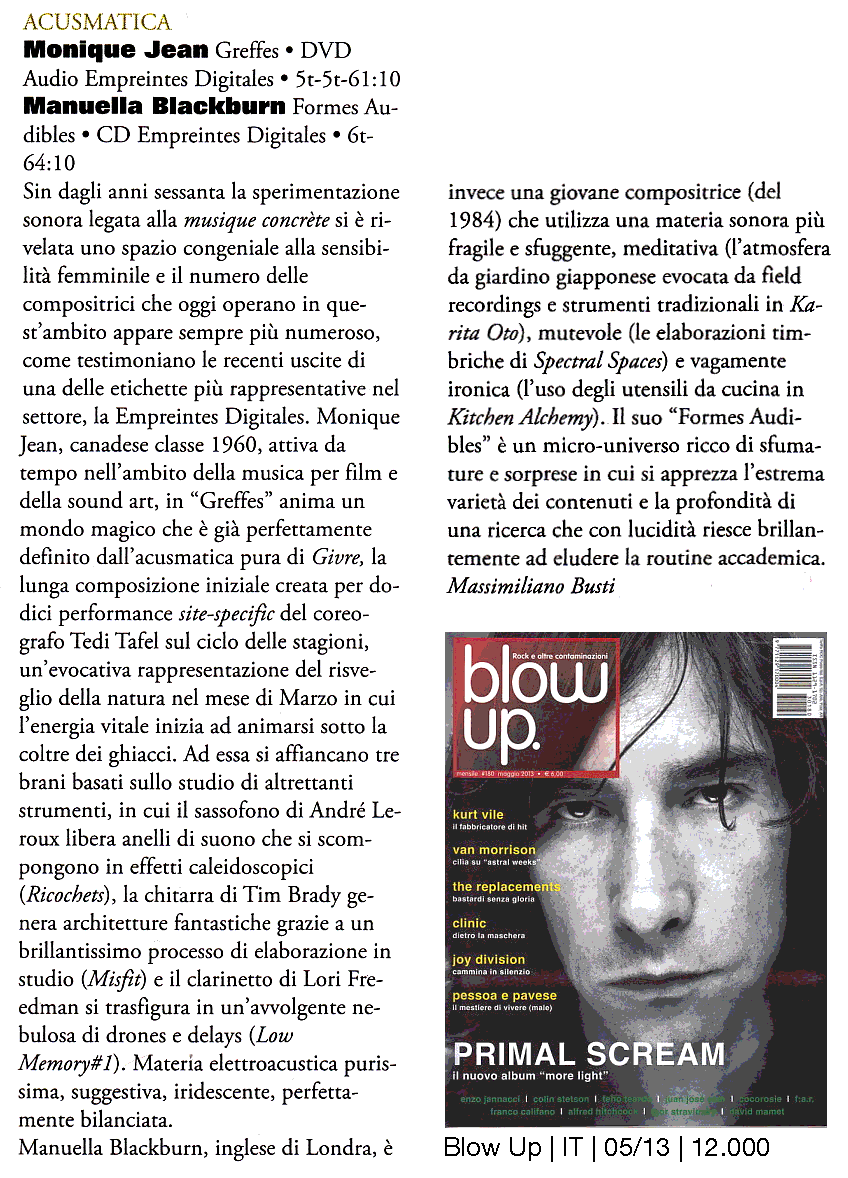
Sin dagli anni sessanta la sperimentazione sonora legata alla musique concrète si è rivelata uno spazio congeniale alla sensibilità femminile e il numero delle compositrici che oggi operano in quest’ambito appare sempre più numeroso, come testimoniano le recenti uscite di una delle etichette più rappresentative nel settore, la empreintes DIGITALes. Monique Jean, canadese classe 1960, attiva da tempo nell’ambito della musica per film e della sound art, in Greffes anima un mondo magico che è già perfettamente definito dall’acusmarìca pura di Givre, la lunga composizione iniziale creata per dodici performance site-specific del coreografo Tedi Tafel sul ciclo delle stagioni, un’evocativa rappresentazione del risveglio della ntura nel mese di Marzo in cui l’energia vitale inizia ad animarsi Sotto la coltre dei ghiacci. Ad essa si affiancano tre brani basati sullo studio di altrettanti strumenti, in cui il sassofono di André Leroux libera anelli di suono che si scompongono in effetti caleidoscopici (Ricochets), la chitarra di Tim Brady genera architetture fantastiche grazie a un brillantissimo processo di elaborazione in studio (Misfit) e il clarinetto di Lori Freedman si trasfigura in un’avvolgente nebulosa di drones e de!ays (low memory #1). Materia elettroacustica purissima, suggestiva, iridescenre, perfettamente bilanciata.
Manuella Blackburn, inglese di Londra, è invece una giovane compositrice (del 1984) che utilizza una materia sonora più fragile e sfuggente, meditativa (l’atmosfera da giardino giapponese evocata da field recordings e strumenti tradizionali in Karita oto), mutevole (le elaborazioni timbriche di Spectral Spaces) e vagamente ironica (l’uso degli utensili da cucina in Kitchen Alchemy). Il suo Forrmes audibles è un mìcro-universo ricco di sfumarure e sorprese in cui si apprezza l’estrema varietà dei contenuti e la profondità di una ricerca che con lucidità riesce brillantemente ad eludere la routine accademica.
Critique
Manuella Blackburn a un cv long comme le bras comme, bien souvent, tous ceux qui évoluent dans la musique électroacoustique et/ou acousmatique. Bien qu’elle ait réalisé de nombreux travaux à travers le monde, Formes audibles est son tout premier album qui paraît sur l’un des labels les plus essentiel dédié à la musique électroacoustique. Composé de six pièces enregistrées entre 2007 et 2011, ce disque nous dévoile une créatrice hors pair. Il est toujours difficile de dégager quelqu’un par rapports aux autres créateurs tant ces derniers sont tous des spécialistes du son, de son organisation, de sa pureté, de sa perfection… Cela se joue sur pas grand chose, sur des détails mais aussi sur un esprit artistiques que les autres n’auraient pas forcément. Certains restent trop techniques ou trop ancré dans les pré-requis du genre pour prétendre accéder à un statut différent de rat de bibliothèque sonore. Manuella Blackburn tente ici, avec une certaine réussite, à s’extraire d’un académisme bon teint dont on a fait largement le tour depuis bien longtemps. Certes, Manuella Blackburn ne s’en échappe pas totalement mais elle propose des œuvres kaléidoscopiques qui n’hésitent pas à mélanger de superbes traitements électroniques à des instruments plus traditionnels. Formes audibles n’est évidemment pas un album facile d’accès et il est largement adepte des formes abstraites mais il y a une réelle volonté d’avancer et de fabriquer des univers foisonnants qui ouvre notre imagination sur d’autres espaces. De fait, Formes audibles ne saurait être cloisonnée mais ce n’est pas non plus un album irraisonné. Tout y est assurément réfléchit, minutieusement préparé, enrichit à merveilles par un traitement d’une rare qualité. Œuvre fantasmagorique qui rend l’abstraction musicale attractive tout en se rapprochant du glitch, Formes audibles touche la perfection et met en lumière une Manuella Blackburn qui risque bien de faire reparler d’elle si elle continue dans cette voie.
Review
A breath of fresh air over electroacoustic and acousmatic scene wafts from renowned Canadian label empreintes DIGITALes, which recently released the very first album by young English sound-artist Manuella Blackburn, whose remarkable curriculum isn’t frankly the one you could expect from a newcomer: she completed her musical studies at the University of Manchester with a Master’s Degree in Electroacoustic Composition with composer and director of Manchester Theatre in Sound (MANTIS) David Berezan and a Philosophiae Doctor with Ricardo Climent, her music has been performed all over the world (Brazil, Canada, Italy, Cuba, France, Germany, USA, Canada, Sweden, Portugal, Costa Rica, Japan, Mexico, Chile, Argentina and so on) at concerts, conferences, gallery exhibitions and festivals and won many international awards and prizes such as Grand Prize in the Digital Art Awards in Fujisawa, Japan, in 2007, two first prizes at Concurso Internacional de Composição Electroacústica Música Viva in Lisbon (Portugal) and many more.
The feature which makes Manuella’s sonic emissions so interesting is the bizarre blitzes of tonal music in the midst of electroacoustic lumps, particularly in the first two tracks of this album, Vista Points, built on different interactions between electric guitar sounds and processed material, and Switched on, which sounds focused on chimes, laminar flows, switches and mechanical devices, where bubbles of tonal music seem to emerge from the depths of deep ponds. Another distinguishing feature of her sonic organisational set-up is the alternation of moments of intense activity and breaks or temporary inactivity, so that it seems that dynamics follows an inner respiratory drive as if each sonic entity is somewhat alive. In addition to the above-mentioned recordings, this feature is clear in the following ones: the engaging automaton of “Japanese” sounds in Karita oto, the amazing flatware and kitchenware powered Kitchen Alchemy, the following Cajón!, which combines the timbre of the Cajón, a Peruvian percussion instrument, “palmas” claps (a clapping technique of flamenco) and other percussive material and the spellbinding gargles of microsounds and onsets of Spectral Spaces.
Critique
Période apparamment propice aux premières parutions discographiques, le début 2013 nous amène sur les traces de Manuella Blackburn et ses Formes audibles. Marchant sur un sentier qui mène du bruitisme alla Gert-Jan Prins à l’électroacoustique de Iannis Xenakis, avec un net penchant pour le second, la compositrice de Manchester raye de son vocabulaire les notions de facilité et de colère. Pas foncièrement accessible au néophyte, son œuvre mérite plusieurs écoutes attentives avant de dévoiler ses saveurs, étrangement pernicieuses et sensuelles.
Critique

Love on the Bits
Période apparamment propice aux premières parutions discographiques, le début 2013 nous amène sur les traces de Manuella Blackburn et ses Formes audibles. Marchant sur un sentier qui mène du bruitisme alla Gert-Jan Prins à l’électroacoustique de Iannis Xenakis, avec un net penchant pour le second, la compositrice de Manchester raye de son vocabulaire les notions de facilité et de colère. Pas foncièrement accessible au néophyte, son œuvre mérite plusieurs écoutes attentives avant de dévoiler ses saveurs, étrangement pernicieuses et sensuelles.
Kritiek
De elektro-akoestische componiste Manuella Blackburn heeft als specialisme ‘acousmatic music’. Die term behoeft wellicht enige uitleg. Kort door de bocht komt dat neer op gecomponeerde muziek die alleen bestaat in de vorm van opnamen en waarbij uitvoering plaatsvindt door het afspelen via luidsprekersystemen van divers pluimage — niet zelden in ‘surround’. Op menig festival voor nieuwe muziek en geluidkunst zoals Kontrase, Today’s Art of Sonic Acts maakt de bezoeker kennis met dergelijk werk.
Het Canadese label empreintes DIGITALes levert een werk voor stereo-opstelling. Deze zes vormen in klank houden de toehoorder van begin tot eind in een dynamische en ijzersterke greep, niet in het minst door klaterende verrassingen en ijzingwekkende spanning. Kristalhelder in toon en verbijsterend briljant opgenomen, weeft Blackburn strengen akoestisch instrumentarium en gevonden of elektronische geluiden door elkaar heen.
Op Formes audibles ligt de nadruk niet op ritme of structuur, niet op textuur of melodie, maar op een fragiele (dis)balans in tonaliteit tussen verschillende instrumenten en de ‘vormen’ die hun klanken schetsen in de ruimte. Die dansen en buitelen over, onder en langs elkaar als elementen uit schilderijen van Kandinsky; speels en dartel in een weldoordacht kader. Ver voorbij de abstractie van een werkelijkheid schept Blackburn een origineel universum in geluid dat barst van de realiteitszin, juist door te excelleren in ogenschijnlijke sonische puurheid en eenvoud binnen organische complexiteit.
Kritik
Die aus England stammende Manuella Blackburn hat an der Universität Manchester studiert. Ihr Schwerpunkt ist die elektroakustische Musik. Doch ihr musikalisches Schaffen reicht weit über dieses spezielle Gebiet hinaus. Instrumental-Kompositionen, Arrangements für Laptop-Ensembles, elektronische Improvisationen und dergleichen mehr zählen ebenso in ihren Wirkungsbereich. Ein Mutitalent. So verwundert es sicher auch nicht, dass sie im Laufe der Zeit immer wieder mit Preisen bedacht wurde. Da wären zum Beispiel der „Grand Prize in Digital Art Awards“ (Japan 2007) und der erste Preis der „Concurso International de Composicao Electroakustica Musica Viva“ (Portugal 2006 und 2009).
Die nun vorliegende erste Solo-CD der Komponistin „Formes audibles“ besticht durch klare und doch komplex angeordnete Strukturen. Sechs Titel, die die Bezeichnung moderne Elektroakustik tatsächlich verdienen. Neben allseits bekannten, klassischen Musikinstrumenten verwendet sie elektronische — auch eine E-Gitarre, was dem Ganzen mal etwas Rockiges und mal etwas Jazziges verleiht. Doch das Instrumentarium umfasst wesentlich mehr. So hören wir nicht nur das Kratzen bzw. Reiben der Finger über die Saiten einer E-Gitarre oder allgemein präparierte Saiteninstrumente, sondern auch Glockenspiele, Klanghölzer, Becken und elektronisch generierte Sounds, die spielerisch zwar, aber sehr dicht und mit einem dynamischen Freiraum, der vom kaum hörbaren Einzelinstrument bis in die Mehrstimmigkeit reicht, die Komplexität der einzelnen Stücke verdeutlichen. Leichtfüßig, ja luftig kommen die einzelnen Titel daher. Immer mit dem richtigen Gefühl dafür, wann es Zeit ist, ein Thema abzubrechen, um es neu aufzubauen oder mit einem neuen zu verbinden.
Der erste Titel beginnt dann auch gleich mit einer E-Gitarre. Hier geht es um die Möglichkeiten eines Spieles damit. Manchmal hat man dabei sogar den Eindruck, dass jeden Moment ein Schlagzeug einsetzt, was allerdings gänzlich ausbleibt. Doch das Kratzen, der dynamische Anstieg und die Dichte des Gespielten erinnern daran, d.h. an schon klassisch zu nennende Muster der Rockmusik, an das Gleich eines Refrains. Allgemeiner ausgedrückt kann hier von einer Anleihe bzw. Reminiszenz an die klassischen Strukturen der tonalen Musik gesprochen werden. Andererseits werden die hörbaren Formen der Manuella Blackburn dann aber modern organisiert, d.h. der Bruch und nicht der lineare Fortgang von einer Idee zur nächsten bekommt hier den Raum, den dieser benötigt, um sich zu entfalten, um gleichzeitig zu enden und neu zu beginnen.
The Wire Tapper 30
